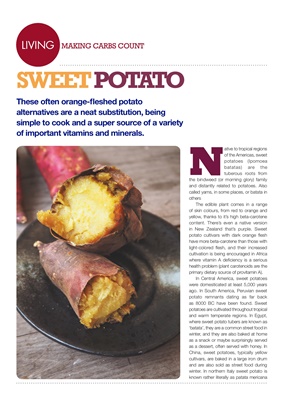
LIVINGLIVING MAKING CARBS COUNT
These often orange-fleshed potato
alternatives are a neat substitution, being
simple to cook and a super source of a variety
of important vitamins and minerals.
Native to tropical regions
of the Americas, sweet
potatoes (Ipomoea
batatas) are the
tuberous roots from
the bindweed (or morning glory) family
and distantly related to potatoes. Also
called yams, in some places, or batata in
others
The edible plant comes in a range
of skin colours, from red to orange and
yellow, thanks to it's high beta-carotene
content. There's even a native version
in New Zealand that's purple. Sweet
potato cultivars with dark orange flesh
have more beta-carotene than those with
light-colored flesh, and their increased
cultivation is being encouraged in Africa
where vitamin A deficiency is a serious
health problem (plant carotenoids are the
primary dietary source of provitamin A).
In Central America, sweet potatoes
were domesticated at least 5,000 years
ago. In South America, Peruvian sweet
potato remnants dating as far back
as 8000 BC have been found. Sweet
potatoes are cultivated throughout tropical
and warm temperate regions. In Egypt,
where sweet potato tubers are known as
'batata', they are a common street food in
winter, and they are also baked at home
as a snack or maybe surprisingly served
as a dessert, often served with honey. In
China, sweet potatoes, typically yellow
cultivars, are baked in a large iron drum
and are also sold as street food during
winter. In northern Italy sweet potato is
known rather literally as patata mericana
SWEET POTATO